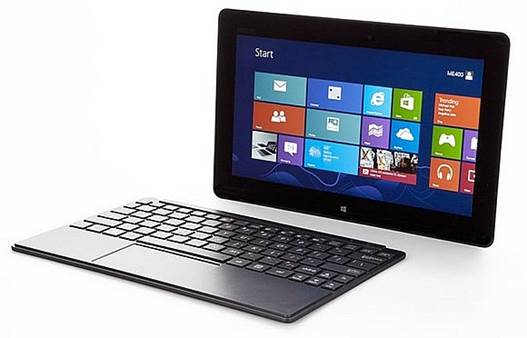With Smart VivoTab, Asus has created a real tablet
running Windows 8 with a suitable price as the iPad and other high-end Android
tablets. At $499, the device is equipped with the Intel Atom processor and 64GB
of internal memory, but more lightweight than the Apple tablet. Asus also
provides users with the option of Bluetooth keyboard which can be folded for
use as a base for the screen. So, users can use the VivoTab Smart as a mini
laptop.
Design

Asus
Smart VivoTab looks quite attractive.
At first sight, Asus Smart VivoTab looks quite
attractive, but because the entire chassis of the device is made of plastic, so
while holding it, users will feel it has a much “cheaper” price when compared
with other tablets using firm metal chassis make such as Microsoft Surface RT
and the iPad. However, the white plastic back cover is capable of effective anti-fingerprint.
The 10.1-inch screen of the VivoTab Smart is
surrounded by shiny black borders, on top of which is the 2MP camera. On the
left is the subtle gray Asus logo. On the back is the 8MP camera and LED flash,
in the middle is a silver Asus logo. On the left side of the device is a
microUSB port, a microSD slot and a micro-HDMI port, while the right side has a
volume control button and a headphone jack.
The power button is on the top edge of the device.
On the upper left corner on the back of the device there is also a NFC chip
that allows users to send and receive applications, images, webpages, etc.
Compared with Lenovo ThinkPad Tablet 2,
Dell Latitude 10 and Microsoft Surface RT, this device also lacks a full-size
USB port.
The VivoTab Smart has a dimension of
271.78x175.26x12.7 mm), so it is thicker than Lenovo ThinkPad Tablet 2
(261.62x165.1x10.16 mm) and Dell Latitude 10 (274.32x177.8x10.16 mm). It is
worth noting that all the three tablets have a weight of 544.31 grams. While
Microsoft Surface RT (274.32 x 172.72 x 10.16 mm) is thinner than the Smart VivoTab,
it’s with 680.38 grams heavier.
Screen and sound

Asus
VivoTab Smart has a 10.1-inch touchscreen of 1,366x768 pixels.
Asus VivoTab Smart has a 10.1-inch
touchscreen of 1,366x768 pixels and uses the IPS panel. Therefore, the display
is very clear and colors are vibrant, which fully meets the great demands for
viewing videos and entertainment.
The screen has light sensitivity of 292
lux, which is higher than the display screen of Acer Iconia W510 (262 lux) but
still lower than the average level (367 lux) of tablets. The touchscreen of
Lenovo ThinkPad Tablet 2 (389 lux) and Dell Latitude 10 (473 lux) are brighter
and higher than the average.
Stereo speakers integrated on the device
are located on the left of the back of the VivoTab Smart, providing average
sound, which is enough to hear in a small room. Although the sound quality is
acceptable, it lacks bass.
The TranSleeve Keyboard

The
TranSleeve keyboard
In addition to the virtual keyboard, users
also have the option of a dedicated keypad for the device called TranSleeve which
has the weight of 408.23 grams and has the price of $129. With TranSleeve users
can just use it as a base for your screen while the keyboard can be used as a
connected wireless Bluetooth keyboard to Smart VivoTab.
The keys on the TranSleeve keyboard are
designed like most keyboard designs of hybrid devices running Windows 8 and
tablets using keypad. So, the keys are smaller than standard keys on the
keyboard, so when working with this keyboard, sometimes users will still make typo
errors.
However, the key is well responsive,
tactile feedback responds and your wrist will still be quite comfortable when
you are manipulating input.
Small touchpad above the lower side of the TranSleeve
keyboard is quite sensitive when we perform navigation tasks in a desktop
environment of Windows 8. All operation gestures in the Start Screen like swiping
from the rightmost edge of the screen in to activate Charms, swiping from the
outer left edge to switch between applications will respond immediately on
action.
While the manipulation gestures for Windows
8 are working well, multi-touch actions on the touchpad like moving two fingers
are not really effective.
Camera
The 8MP camera on the back of the VivoTab
Smart can take sharp photos especially when shooting outdoors in full light
conditions. When using the device's main camera to capture moving images such
as people doing exercises, pedestrians going on the road or motorbikes running
on the road, the images are blurry. The rear camera can record 1080p-resolution
videos with sharp images.

A
photo taken by Asus VivoTab Smart
The 2MP front-facing camera can also take
pictures with clear display quality and has capabilities of reproducing accurate
colors, which fully meets the needs of video chatting.
In addition to the camera application that
comes in Windows 8 by default, Asus also installed on the Smart VivoTab a
separate camera application, which offers users a variety of effect options,
adjusting white balance and the ability to turn on/off flash on demand. This
application also supports shooting panorama very well.